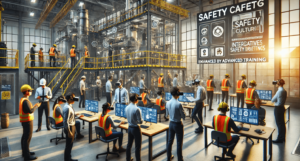In today’s fast-paced and increasingly mechanized work environments, establishing a robust safety culture is not just a regulatory requirement; it’s a cornerstone of organizational success. A strong safety culture supports employee wellbeing, optimizes productivity, and mitigates risks associated with workplace accidents. However, developing such a culture goes beyond traditional audits and compliance; it demands comprehensive training and the integration of advanced training technologies. As businesses strive to navigate the complexities of workplace safety, the emergence of virtual training and artificial intelligence offers promising avenues to enhance and foster a culture rooted in prevention and proactive risk management.
This article explores the essential role of a well-entrenched and the transformative power of advanced training methodologies in shaping it. It examines how the adoption of innovative training techniques, including virtual reality and AI-driven simulations, can revolutionize safety education, making it more engaging, effective, and accessible. Furthermore, the article delves into the implementation of these technologies in workplace safety training programs, methods for conducting thoroughness that align with modern safety standards, and strategies for measuring the impact of enhanced safety training on overall. By providing a roadmap for integrating cutting-edge training solutions, this narrative underscores the importance of an adaptive safety culture in the current industrial landscape.
Understanding the Need for a Safety-First Culture
Importance of Employee Safety
A is pivotal in preventing illnesses, and deaths, which not only affect workers and their families but also impose financial hardships on employers. Traditional safety approaches, where actions are taken post-incident, are proving inadequate. Instead, a proactive management of workplace safety and health, where hazards are identified and rectified before causing harm, is now recommended. This proactive approach not only helps in preventing workplace incidents but also improves compliance with laws and regulations, reduces costs, including workers’ compensation premiums, and increases productivity.
For example, all companies should have a strong safety culture that emphasizes the protection of employees, visitors, and contractors. Encouraging every employee to voice concerns about potential hazards demonstrates a collective commitment to maintaining a safe work environment. This commitment is reflected in the organization’s focus on preventing harm, maintaining vigilance, and ensuring adherence to safety protocols.
Impact on Organizational Success
The benefits of a well-established safety culture extend beyond mere compliance and injury prevention. Organizations like Northrop Grumman experience enhanced productivity, quality of work, and employee morale, leading to higher-quality products and services. A positive safety culture significantly reduces the risk of accidents and injuries, thereby safeguarding employees’ physical and mental health and promoting a more engaged and motivated workforce.
Moreover, organizations with a strong safety culture report lower absenteeism, reduced incident rates, and increased efficiencies, which collectively contribute to improved business operations and a robust corporate image. The commitment to safety is not just about adhering to regulations but is a core part of the organizational ethos that every employee from top management to frontline workers embraces and actively participates in.
By fostering a culture where safety is ingrained in every aspect of operations, businesses can achieve a sustainable safety environment that protects workers and contributes to the overall success and resilience of the organization.
Role of Advanced Training Technologies
VR and Virtual Simulations
Virtual reality (VR) significantly enhances the safety training landscape by providing immersive simulations where workers can engage in realistic scenarios without the risks associated with actual environments. These VR experiences are not only safer but also more cost-effective, eliminating the need for physical training spaces and equipment. Companies like Shell and BP have utilized VR to simulate emergency situations, dramatically improving outcomes and reducing training costs. Moreover, VR technology allows for the repetition of scenarios, ensuring that workers can practice until they master necessary safety procedures, thus enhancing retention and reducing the likelihood of accidents.
Gamification in Training Modules
Gamification applies game design elements in non-game contexts, such as safety training, to make learning more engaging and effective. By integrating elements like point scoring, competitions, and rules of play, gamification motivates employees to participate actively and achieve safety goals. For instance, turning safety training quizzes into games can make the learning process more interactive and enjoyable, encouraging better engagement and retention of safety practices. Additionally, serious games designed for training purposes allow employees to experience realistic challenges and receive instant feedback, which supports effective learning and behavior change.
AI-Driven Insights and Analytics
Artificial Intelligence (AI) enhances safety training by providing data-driven insights and predictive analytics. AI technologies, such as machine learning and natural language processing, analyze vast amounts of data to identify patterns and predict potential safety issues before they occur. This proactive approach allows organizations to address risks promptly, enhancing overall safety outcomes. AI-driven VR and AR simulations not only train workers in complex scenarios but also adjust the training modules based on individual performance, ensuring personalized learning experiences that target specific skill gaps. Additionally, AI-powered analytics platforms can monitor and evaluate the effectiveness of safety training, enabling continuous improvement and adaptation to new safety challenges.
Implementing Advanced Training in the Workplace
Tailoring Training Programs to Job Levels
Organizations are increasingly recognizing the need to customize training programs to the specific roles and experience levels within their workforce. By conducting thorough needs analyses, companies can identify specific skill gaps and learning preferences, allowing them to design training initiatives that are directly aligned with the needs of their employees. This tailored approach not only enhances the effectiveness of training but also supports employee engagement and retention by addressing individual learning styles and career development needs.
For instance, differentiating training content for entry-level employees versus seasoned veterans ensures that each group receives relevant and appropriate instruction, maximizing learning outcomes and operational efficiency. Moreover, the integration of technologies like Virtual Reality and Artificial Intelligence in training programs offers interactive and engaging methods that cater to a diverse workforce, potentially increasing retention rates and reducing the risk of workplace incidents.
Overcoming Resistance to Change
Introducing new training technologies and methodologies in the workplace often encounters resistance from employees who are used to traditional learning methods. To effectively manage this resistance, organizations need to implement strategic change management practices. Engaging employees early in the process helps clarify the benefits and necessity of the new training initiatives. Leadership plays a vital role in this transition; by showing commitment and enthusiasm for the new methods, leaders can inspire similar feelings throughout the organization. Additionally, providing continuous support and resources, such as personalized learning plans and access to new training tools, can reduce fears and encourage acceptance.
Organizations can further reduce resistance by incorporating microlearning techniques, which involve short, focused training sessions that fit naturally into the working day and cater to the modern attention span. This method not only makes the training more digestible but also allows for immediate application of learned skills, reinforcing the practical benefits of the new training approaches.
Measuring the Impact of Safety Training
Tracking Incident Data
To assess the effectiveness of safety training, organizations often rely on lagging indicators such as lost workdays, workers’ compensation payouts, and injury frequency. These indicators provide valuable insights into past compliance with safety guidelines. On the other hand, leading indicators like safety training sessions, audits, and equipment maintenance are predictive measures that help prevent incidents. By enhancing these leading indicators, organizations typically see improvements in their lagging indicators, such as a decrease in machinery-related injuries following increased lockout/tagout training.
Gathering Employee Feedback
Gathering and analyzing employee feedback is crucial for measuring the impact of safety training. Employees can offer unique insights into the strengths and weaknesses of safety programs, making their feedback a vital component of continuous improvement. Organizations should create an environment that encourages feedback by providing anonymity and incentives, and by holding regular meetings to discuss health and safety policies. Additionally, using digital tools like mobile apps for accessing and near-miss reports can enhance the accessibility and effectiveness of this feedback.
By implementing systems that track both incident data and gather comprehensive employee feedback, organizations can create a robust framework for evaluating the success of their safety training programs and making informed decisions to enhance workplace safety.
Conclusion
Throughout this discussion, we have delved into the imperative of fortifying workplace safety culture through state-of-the-art training methods, emphasizing the transformative potential of technologies such as virtual reality and artificial intelligence in safety education. By illuminating the intrinsic values of a safety-first culture and the impact of advanced training technologies, the narrative has not only outlined the critical pathway towards enhancing protective measures in diverse work environments but has also showcased exemplary initiatives by leading corporations that have effectively integrated these innovations into their safety training programs. These measures, as explored, not only bolster employee well-being and organizational productivity but also significantly reduce the risks associated with workplace mishaps.
As we conclude, it’s pivotal to reflect on the overarching significance of fostering a robust safety culture, underscored by comprehensive and adaptive training solutions. The journey towards achieving an optimal safety environment is continuous, accentuating the need for persistent evaluation, feedback incorporation, and the adoption of emerging technologies to tailor safety education to the evolving workplace dynamics. The insights presented affirm that a culture rooted in proactive risk management not only safeguards employees but also propels organizations towards sustainable success. Thus, advancing towards more sophisticated and immersive training methodologies remains a critical endeavor for businesses aiming to nurture a truly workplace culture.
FAQs
- How can a strong safety culture be established in an organization?
To establish a robust safety culture within your organization, begin by clearly defining. Leadership should model safety priorities from the top down and hold everyone accountable. Empower employees with the authority to halt operations if they perceive safety risks and ensure there are effective communication channels available for them to voice concerns and suggestions. - What are three key actions leaders should take to foster a strong safety culture?
Leaders can strengthen safety culture by demonstrating a firm commitment to safety, enhancing employee involvement and engagement initiatives, and consistently measuring and evaluating the progress towards achieving safety excellence. - What strategies can be employed to enhance safety culture at the workplace?
To enhance your workplace’s safety culture, secure commitment from both upper management and employees. Collect meaningful safety data, establish a dedicated team and set clear safety goals. Prioritize safety as a core organizational value, communicate effectively, empower employees, focus on continual improvement rather than perfection, and adjust the work environment to support practices. - How can an improved safety culture be developed?
Developing a better safety culture involves ensuring that employees have access to necessary safety information such as and methods for reporting safety hazards. Management should encourage a culture where employees feel safe to express safety concerns and should address these concerns promptly and effectively.


